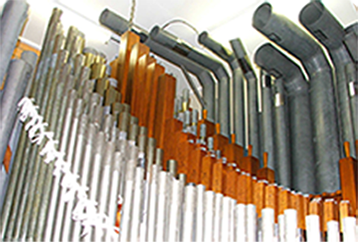Have you ever sat down at an unfamiliar organ at Open Console and been confused about the nomenclature on the percussion sections of the stop rail? This article will attempt to sort out the differences.
Percussion instruments make sound by being struck. Common examples are drums, cymbals and tambourines. Tuned percussions play notes up and down the musical scale as they are struck. The most well-known tuned percussion instrument is the acoustic piano in which hammers strike strings to produce the different notes.
In the organ, let’s start out with the metal tuned percussions. – “Chimes” generally mean a set of tubular hanging bells struck by mallets, similar to those seen in an orchestra. Easy enough.
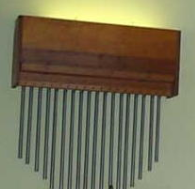
Unenclosed Set of Organ Chimes
“Glockenspiels” are familiar to most people from being heard at parades in marching bands. They are structured in the form of a 25 note lyre for this purpose. In orchestras and organs, they are a series of metal bars, usually with a 30 note compass, located high in the piano range of notes. Some have resonators (hollow metal tubes with the bottom stopped, placed beneath the bars to “resonate” the sound). Struck with a mallet, each bar sounds 2 octaves higher than the written music, thus the “tinkly” sound.
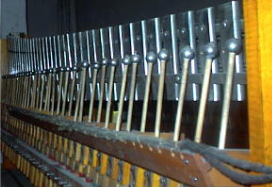
Organ Glockenspiel
“Orchestra Bells” are generally considered identical to the “Glockenspiel”. In some organs Orchestra Bells have the option to be hit repeatedly when the note on the console keyboard is pressed (reiteration). Glockenspiel stops, on the other hand, generally do not feature reiteration. In fact, if you sit down at a console and see a stop labeled “Glock” and another labeled “Orch Bell re-it”, most probably there is one metal bar instrument in the chamber. Select the “Glock” tab and the bars are struck once. Select the “Orch Bell re-it” tab and the same bars are struck repeatedly.
There are two more names for similar instruments: “Chrysoglott” is a Wurlitzer term synonymous with “Celesta”. Both are basically a Glock-like instrument that plays one octave higher than the written music (rather than 2) and with a softer sound.
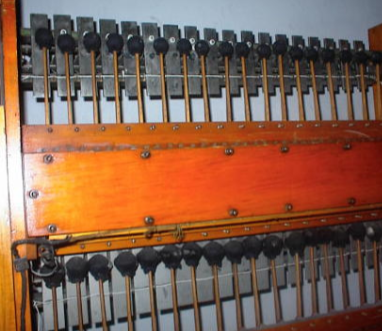
Wurlitzer Chrysoglott
So, if you sit down at an unfamiliar console and want a bell-like tinkling sound, Glockenspiel, Orchestra Bells, Chrysoglott, or Celesta should do the trick. Just be careful to note which are set up to reiterate, and which aren’t!
A “vibraphone” or “vibraharp”, is a unique tuned percussion. Made with metal bars and metal resonators it generally has a 3 octave compass located in the middle of the piano keyboard range (lower than Glock / Orch Bells). The instrument sounds exactly at the point of the written music, not octaves higher or lower. The combination of metal bars being struck by mallets with metal resonators beneath can result in the sound echoing too long. In an orchestral vibraphone, felt dampers and a pedal are utilized to dampen the sound, similar to a piano pedal. What makes the vibraphone sound unique, is a series of rotating discs which open and close the tops of the resonators, thus creating the vibrating sound for which the instrument is named.
Now on to the wood instruments- “Xylophones” are wood bar instruments, John C. Deagan’s experiments proved that rosewood from Honduras produces the best sound. The note compass is usually 3 ½ octaves, set higher on the piano keyboard than the vibraphone, but lower than the glock. Xylophones produce sound one octave higher than the written music. The metal tube resonators beneath the bars are generally fairly short. The tone has a dominant 5th that distinguishes it from the other tuned percussions. This all results in the familiar “boinking” type sound when the bars are struck. Some organs offer a reiteration option on their xylophones.
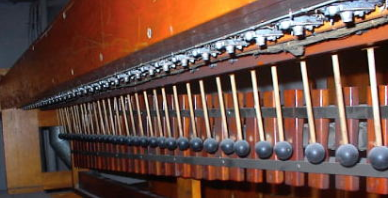
Organ Xylophone (The ends of the resonators can be seen peeking between the near wood bars)
The “Marimba” or “Marimba Harp” is a close cousin to the xylophone. Originating in Africa and Central America, the first Marimba’s had wood bars and wood gourd resonators. Today’s Marimba has thinner wood bars than a xylophone, and the lower notes are wider. Marimbas can encompass 5 octaves in the middle of the piano range. Their metal resonators are generally longer than those of a xylophone. The instrument sounds at the same pitch as the written music (not one octave higher as in the xylophone). This combination of bars and resonators results in a lower range, mellower, more resonant sound than a xylophone. On theatre organs, Marimbas are often set up with a reiteration option.
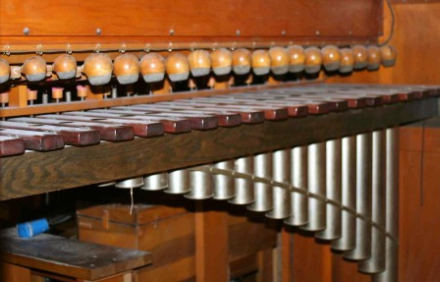
Organ Marimba Harp
The Harp terminology – Didn’t you all think a harp was a stringed orchestral instrument, (generally looking like the guts of a grand piano turned on end), which is played usually by a charming lady in a flowing dress who plucks the strings? So did I, and so do virtually all on-line dictionaries! It appears that somewhere along the way the theatre organ industry adopted the name to mean a struck tuned percussion which tries to imitate a stringed Harp. According to the “Encyclopedia of Organ Stops”, Harp bars can be wood or metal (distinctly different sounds!). It appears that a Harp plays at the same pitch as the written music. Thus the term could stand for a metal bar Vibraharp type instrument (without the vibration), or it could stand for a wood bar Marimba type instrument. One source indicates that if you see “Harp” on the stop rail along with “Marimba”, the bars of the same instrument in the chamber will be struck once if you select “Harp” and repeatedly if you select “Marimba”.
The mallets – Since all these instruments are percussion ie the tuned bars are struck by something, this brings up the subject of mallets. Mallet heads can be made of yarn, rubber, wood, plastic, metal, or can be one of these materials covered with cloth. Naturally, the material used will affect the sound. There does not seem to be any consistency here, and orchestral musicians like to experiment with different materials.
The suspension – Since the bars on all these instruments vibrate to create the sound when struck, how they are connected to the frame is very important. Old dried out hard rubber connections when replaced with a softer material can have a dramatic positive musical effect!
Are we still confused, or is everything now clear as a bell?? (pun intended).
The problem with all this is that there are few standards or agreements as to specifications for these instruments. The percussion manufacturers and the organ manufacturers did and do what they please regarding instrument design and nomenclature.
Bottom line: Do not despair! When trying out an organ which is new to you, experiment with the tuned percussion stops to determine the sound and the range on the keyboards, listen with your ears, and have fun!






